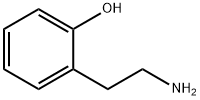2-Hydroxyphenethylamine (also known as phenylethanolamine) is a kind of trace amine found in the brain. It may modulate the sympathetic functions. It has strong cardiovascular activity, and can be used as a drug to produce topical vasoconstriction. Its derivatives are adrenergic agonists and antagonists, and have the potential for the treatment of respiratory diseases.
2-(2-aminoethyl)phenol is a ortho-hydroxylated phenylethylamine present in urine of patients with affective disorder following (MAO-inhibiting) antidepressant drug treatment. It has been used in studies as a substrate of monoa mine oxidase B and was revealed to be a potential inactivator of MAO-B.
A ortho-hydroxylated phenylethylamine present in urine of patients with affective disorder following (MAO-inhibiting) antidepressant drug treatment. It has been used in studies as a substrate of monoamine oxidase B and was revealed to be a potential inactivator of MAO-B.
ChEBI: 2-(2-aminoethyl)phenol is a primary amine.
https://en.wikipedia.org/wiki/Phenylethanolamine
Biggadike, Keith, et al. "PHENYLETHANOLAMINE DERIVATIVES FOR THE TREATMENT OF RESPIRATORY DISEASES." WO, EP 1556340 A1. 2005.
https://pubchem.ncbi.nlm.nih.gov/compound/2-Amino-1-phenylethanol#section=Top


